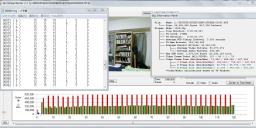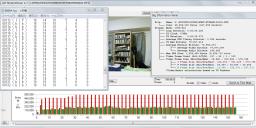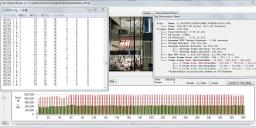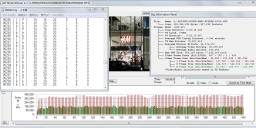
-
"BUT, reality check, the event of the scene happens so damn fast that most viewer wont see ANY difference AT ALL in real time playback. So why do we care honestly? I guess most of you have heard this sentence many times "I watched the footage on my 42'inch tv and it looked great!", was it shot with Arri Alexa? I don't think so. "
@fix: i am not sure, whether i understand you correctly, but that sounds partly like a pleading for mediocrity. I was working at a tv station for quite some time and saw colleagues broadcast technically slightly deficient material just out of lazyness: "the viewer wont notice" and in fact he did not (and it was not some stupid tv station, but one of europes biggest). I think the habbits or abilities of the viewer or consumer should never set the standard. Just look how many people consider going to McDonalds having gourmet food. Same applies to literature, clothing, you name it. I think one should always strive to get the best out of each situation. If you notice you dont give a donkeys about the outcome of a project you are waisting your own valuable time the most and should better do something else.
I must admit, that i sometimes struggle to really see a difference between the top settings. I need frame by frame comparison in those cases. But that doesnt mean it is not there for better trained eyes. And i am really thankful for the work of driftwood, lpowell and bkmcwd, their settings i use the most.
I have a modest collection of old primes and i think if you take the camera out of the box, the lens is the easiest and most efficient to change the look of your filming.
-
Many thanks guys for significant arguments! It may be the quantity of English required for one week for me to understand. LOL
"I would hope that differences between FM2 and GOLGOP3 looks would be clearly visible - the very purpose of having different matrices is to offer such differences, otherwise why bother? There is no such thing as a perfect matrix - there are ones for particular applications, and others for more general use."
Yes, we must not forget this. Although I do not deny evaluation subjective, of course...
Although I am making various settings, what I aim at is a setting in which a problem does not occur at all in at least 95 MB/sSDXC card use. About subjective liking, I leave it to those who use. And I also think it significant to exchange PERSONAL VIEWs mutually. :-)
BTW, since the confusion about my settings has arisen here, I explain correctly. It is about my settings among three sorts of settings which @towi compared in HBR.
Valkyrie 444 TYPE-ZERO2 C1.3 : With Modified Chris's pure original 444 matrix
GOLGOP3-13-A : With My original matrix named 'EX Matrix'
It is only Valkyrie that I have applied 444 concepts by Chris and Nick. There is character near the Sedna matrix of Nick in 'EX matrix'.
-
You are onto a very interesting subject I think. I have encounter some interesting experiences regard codecs on different cameras. Example, imagine a static shoot (interview, 60 min style).. The 24mbit compression on the Nikon d800 will, hands down, look much much better than any All-I patch for the gh2 if you freeze the frame and start looking for digital artifacts and finer grain detail. People may not believe it. But try it out and be amazed. The d800 has a much more efficient codec than the gh2, that's it I guess. Forget about the moire and aliasing problem with the d800. I know those are issues compared to the gh2, but not the point in this matter.
On the other hand, If you throw the camera around (fast action) an you freeze the picture and start pixel pip, than the all-I ( and FM btw) will be much better looking on that particular frame (less macro block noise and so on). Someone will find that as a holy grail.. BUT, reality check, the event of the scene happens so damn fast that most viewer wont see ANY difference AT ALL in real time playback. So why do we care honestly? I guess most of you have heard this sentence many times "I watched the footage on my 42'inch tv and it looked great!", was it shot with Arri Alexa? I don't think so.
Btw did you guys know that there is a couple of shots made with the 5d mkII in the last Avengers movie (they sad so on fx guide, but never pointed out which shoot though)? Do any of you know which shot?
-
@jrd When you consider that hand-tuned quantization matrices lie at the heart of all JPEG, MJPEG, and H.264 encoders, it's remarkable how little documentation and statistical evaluation I was able to find on their design and performance. In the field of perceptual audio compression, the industry has developed standardized MUSHRA tests to quantitatively evaluate the perceived quality of lossy audio encoding. This practice has had a major impact on the development of new audio compression techniques.
In the world of video, I haven't found any evidence of comparable evaluation tests on video compression quality. I suspect one of the reasons is that video codec development has been predominantly driven by commercial requirements to minimize the data size of video files while maintaining "acceptable" motion picture quality. The conundrum there is that what's considered "acceptable" video quality has changed dramatically in the transition from DVD to Blu-ray media. Moreover, the technical requirements for recording high-quality source video are vastly different from what's needed for consumer-grade distribution of finished products. AVCHD, in particular, was not originally developed or evaluated for use as a motion capture codec.
In short, this entire field is currently a "black art" lacking in well-documented perceptual encoding theory and practice. What exists is engineering lore based on reference implementations from standards committees and track records of encoders successfully used for similar purposes. That makes it an interesting challenge for me, since it requires engineering intuition as well as skillful testing procedures. But to evaluate the results rigorously would require extensive statistical testing programs involving a wide variety of subject matter and human participants. That would be a project whose scope is well outside my own resources.
-
Actually, most of these settings were produced with a lot of controlled (and uncontrolled) testing. The problem is that everybody has a different workflow and different ways of dealing with captured footage, so controlled tests that cover the entire process aren't really possible. I will say one thing, though - sometimes the best footage for the purposes of post processing doesn't look all that good initially. Although, if you have to change it too much in post quality will suffer.
-
Agreed, that differences may not be in the realm of better or worse, and with the additional proviso that gradeability of the footage may render any perceived differences out of the camera moot.
It's just that the differences themselves -- good, bad, agnostic -- remain largely undocumented. Granted, nobody here is getting paid to do that work, and few are well equipped to do it anyway, with controlled conditions. Just that, in the absence of controlled testing, drawing any conclusion can be a challenge, even in the realm of the wholly subjective....
-
Lee brings up an interesting issue. True, the 444-soft matrix works on the opposite theory used to produce the ones in FM2. One of the great things about the availability to modify matrices is that they can be changed to achieve a desired aesthetic. For example, you would probably not use the same matrices for nature films as for narrative films, as the "look" you want will vary considerably. I got this idea because I noticed that some movies used custom matrices when transferred to DVD in order to preserve a particular look - and those matrices varied quite a lot!
Would you say Fuji motion picture film is better than Kodak? I don't think it possible to make that general a determination. It depends on the "look" you want, and that's subjective.
I would hope that differences between FM2 and GOLGOP3 looks would be clearly visible - the very purpose of having different matrices is to offer such differences, otherwise why bother? There is no such thing as a perfect matrix - there are ones for particular applications, and others for more general use.
I've been doing photography for most of my life. The idea of using only one type of film seems unimaginable. The same goes for attempting to find one matrix that fits all purposes. Playing around with different matrices hasn't been explored much up to now - but I think there is a lot of potential.
-
@jrd There are several things to bear in mind with these types of comparisons. If you take a close look at the comparison @towi uploaded in the first post here:
This video was intentionally shot defocused and underexposed with virtually no edge details. Regardless of the patch, this type of subject will show the GH2 at its very worst. What this reveals is how crudely the camera performs in extremely poor shooting conditions. That's not a criticism of the test - I think it was well chosen to highlight this problematic aspect of the GH2's encoding behavior.
The accompanying Stream Parser chart of the three tested patches (decoder_comp.png) demonstrates another aspect of the encoder's behavior. It shows what each patch does when there's virtually nothing but low-level noise to encode. The numbers in the DC column indicate the minimum degree of quantization used by the encoder in each frame. The lower the number, the finer the quantization, and the higher the required bitrate.
What I can tell you about Flow Motion v2 is that in this case it's performing exactly as intended, encoding all frames at its finest DC quantization level of 5. One reason I chose that number is because it's the finest degree of quantization I was able to persuade the encoder to maintain consistently all the way up to 100Mbps. The other reason, as Chris Brandin has explained, is that DC quantization levels less than 5 are below the mathematical limit of measurable improvements in image quality.
However, that doesn't necessarily mean that extremely fine quantization, such as what GOLGOP3 produces here, has no visible effect on the encoded image. It just means that we can no longer objectively measure its effect on image quality. Likewise, the visual differences between the 444-soft matrix used in this version of GOLGOP3 and the custom matrix in FM2 become increasingly subjective as the content becomes increasingly random.
Personally, after analyzing the technical aspects of the GH2's performance in low-contrast, under-exposed conditions, my conclusion is this: it sucks. The image sensor is too noisy and the encoder has nowhere near enough color depth to do a presentable job of encoding low-level noise. To my eyes, the chroma noise in near black shadows looks especially bad - persistently oversaturated and blotchy with gross macroblock artifacts where it cuts off to pure black. In my view the AVCHD encoder deals with this in a dysfunctional manner, and fails to reduce the saturation of near-black colors according to well-known psycho-visual principles (namely, that human vision becomes increasingly monotonic as illumination is decreased).
Philosophically, I understand that what I consider random noise is what others seek to cultivate as "film grain". I'm not claiming you're wrong, just that esthetically, I don't perceive it that way. If I want to see film grain in a particular video, there are many excellent filters I can use to simulate it in a controlled manner. To facilitate this approach, I tweaked the quantizing matrices I designed for Flow Motion v2 to suppress finely detailed chroma noise, while increasing its sensitivity to fine luma details. The 444-soft matrix used in GOLGOP3 actually does the opposite and the difference is clearly visible to my eyes.
-
That's a perfectly understandable concern! But I for one have posted comparisons in the past and then the debates started that the shooting conditions may have changed, that the scene is not appropriate for a comparision... or that the files are transcoded to QT (the most funny objection... as also native MTS files get transcoded in the moment you display them on monitor through a software). Then we have people viewing files in QT, in VLC, in IrfanView, in an editing software... some view them remapped to fullswing, some view them at rec709 on a computer monitor, some on a TV monitor. And so on... I do understand the demand for comparisions... but I don't see that comparisons proof anything (or that comparisions are considered as beeing a proof).
-
The settings are available for everyone here on the forum. Load them, compare the results and draw your own conclusions. It's not a big deal ...
Consider that there are thousands of posts here, and almost no objective examination of the claims made for any given setting. On the other hand, no setting is going to overcome the limitations of the camera, so the margin of improvement we're arguing over is going to be small; the GH2's own menu settings will likely have a far greater effect. There is, however, a wish that claims would be substantiated.
-
"I have no dog in the fight..."
me neither. I happily throw away my own settings (even when it took weeks to tune them), if settings of someone else look better. I really don't care who made the settings. I've used FloMo 2 for a while as it provides very good 25p. But the latest Valkyrie and GOLGOP13-A settings look even better in 25p. That's all.
Please note that my statement you've quoted above starts with "In HBR (25p) mode...". So my conclusion only applies to this particular mode, not to the respective settings in all modes.
The settings are available for everyone here on the forum. Load them, compare the results and draw your own conclusions. It's not a big deal ... and above all you can control the test conditions by yourself. This way you can also be sure that the comparision is not biased. Well... at least I've provided some numbers from one of my comparisions: http://www.personal-view.com/talks/discussion/comment/88273#Comment_88273.
-
@jrd I wouldn't mind seeing a comparison either....as long as it's reasonable and doesn't get into the sub atomic level. I kind of hate to see these comparisons get to "my setting is better than yours", though.
bkmcwd, LPowell, Ralph. Driftwood, Vitaliy and a host of others have dedicated a lot of time to come up with these settings and really....made history.
All the settings have their merits and their strong and weak points.
-
look so much better than FloMo2 with regard to macro blocking and noise in shadows
I have no dog in the fight, if it is a fight, but a lot of users would likely be interested in seeing the comparisons you did to arrive at this conclusion. If it's more a general feeling than an actual comparison, fine and well, but that's another matter entirely....
-
@ GOP3ZILLA lovers :-)
"GOP3ZILLA_3_Candidate 1"
I release the first candidate for "GOP3ZILLA_3" setting.
This is the simple setting which harnessed the feature of the stock as it was.
I think that 1080i and HBR especially in PAL of these settings are improved rather than Previous BETA versions.
Although I am preparing other candidates, if they are not satisfactory, I will make this C1 the official setting.
Please try it! And many thanks for your feedbacks!
*Of course, already combined with excellent audio tune @thepalalias's "Pasadena_Pulse_Audio_V2_Beta2"
NOTE:
*Although bit rate setups are quite high, the bit rate which actually appears are lower than these. Since the actual bit rate changes by the object to shoot, please confirm by yourself.(Max bitrate : about 100M in 24p, about 75M in HBR.)
*24H and 24L are high quality 3GOP setting with mega size I-frames.
*24p80%(30p) is available in 24H & 24L both.
*60i, 50i, HBR30p and HBR25p are also high quality and stable 3GOP settings.
*720/50p and 720/60p are 6GOP and 9GOP. It has tuned up so that the bit rate at the time of motion may go up rather than the time of statics.
*I especially recommend you use with SanDisk 95MB/s 64GB SDXC card.
*In camera playback is available in all rec mode, at least available after reboot the camera.(Not tested full yet, but probably)
*EX Tele, iA mode work.(Not tested full yet, but probably)
*Spanning in 24H, 24L with SanDisk 95MB/s 64GB SDXC Card. In other rec mode, need test.
*Spanning in other cards needs to be tested.

 bkmcwd GOP3ZILLA_3_Candidate1.zip859B
bkmcwd GOP3ZILLA_3_Candidate1.zip859B -
While waiting for the feedbacks from people, I am tweaking GOP3ZILLA now. :-)
-
@Mirrorkisser IMO, top priority is given to gradation in Valkyrie. In GOLGOP3-13, I took the balance of gradation and resolving into consideration. Although I am not sure whether it has done just like that... :-)
-
@bkmcwd: thanks for the new golgop. Apart of the file size, how would you characterize the biggest visual differences between golgop and valkyrie? Thank you!
-
@ GOLGOP3-13 lovers :-)
"GOLGOP3-13-A_Candidate 1" and "GOLGOP3-13-MAX_Candidate 1"
I release the each first candidates for "GOLGOP3-13-A" and "GOLGOP3-13-MAX" settings.
I think that 1080i and HBR especially in PAL of these settings are improved rather than Previous BETA versions.
Although I am preparing other candidates, if they are not satisfactory, I will make these C1s the official settings.
Please try them! And many thanks for your feedbacks!
Special thanks to @towi! :-)
*Of course, already combined with excellent audio tune @thepalalias's "Pasadena_Pulse_Audio_V2_Beta2"
NOTE:
*Although bit rate setups are quite high, the bit rate which actually appears are lower than these. Since the actual bit rate changes by the object to shoot, please confirm by yourself.(Max bitrate : about 100M in 24p, about 75M in HBR.)
*These two settings are completely the same except 24p.
*24H and 24L are high quality 3GOP setting with mega size I-frames in GOLGOP3-13-A.
*24H and 24L are high quality 3GOP setting with super mega size I-frames in GOLGOP3-13-MAX.
*24p80%(30p) is available in 24H & 24L both.
*60i, 50i, HBR30p and HBR25p are also high quality and stable 3GOP settings.
*720/50p and 720/60p are 6GOP and 9GOP. It has tuned up so that the bit rate at the time of motion may go up rather than the time of statics.
*I especially recommend you use with SanDisk 95MB/s 64GB SDXC card.
*In camera playback is available in all rec mode except 24p in GOLGOP3-13-MAX, at least available after reboot the camera.(Not tested full yet, but probably)
*EX Tele, iA mode work.(Not tested full yet, but probably)
*Spanning in 24H, 24L with SanDisk 95MB/s 64GB SDXC Card. In other rec mode, need test.
*Spanning in other cards needs to be tested.

 bkmcwd GOLGOP3-13-A_Candidate 1.zip1K
bkmcwd GOLGOP3-13-A_Candidate 1.zip1K
 bkmcwd GOLGOP3-13-MAX_Candidate 1.zip1K
bkmcwd GOLGOP3-13-MAX_Candidate 1.zip1K
 GOLGOP3-13-MAX_C1_24p_12mm_ISO800_Nos_room_sp_qp.JPG1296 x 634 - 513K
GOLGOP3-13-MAX_C1_24p_12mm_ISO800_Nos_room_sp_qp.JPG1296 x 634 - 513K
 GOLGOP3-13-MAX_C1_HBR30p_12mm_ISO800_Nos_room_sp_qp.JPG1298 x 632 - 524K
GOLGOP3-13-MAX_C1_HBR30p_12mm_ISO800_Nos_room_sp_qp.JPG1298 x 632 - 524K
 GOLGOP3-13-MAX_C1_24p_35mm_ISO400_night_sp_qp.JPG1298 x 633 - 527K
GOLGOP3-13-MAX_C1_24p_35mm_ISO400_night_sp_qp.JPG1298 x 633 - 527K
 GOLGOP3-13-MAX_C1_HBR30p_35mm_ISO400_night_sp_qp.JPG1297 x 632 - 531K
GOLGOP3-13-MAX_C1_HBR30p_35mm_ISO400_night_sp_qp.JPG1297 x 632 - 531K -
@Mrhechang Many thanks for wonderful sample footage, mate! :-) You made me think that I would also like to go to Yotsuya.
-
@Bonzai "AWB" 5 'clicks' toward the blue?
Yes! That's right.Sorry,I forgot to write"B". -
@Mrhechang - I like it! Music, style, the whole package :-) The look is just what I want for 'street shots'.
Showing it with no color grading is most helpful to me as I'm no pro cinematographer by a long shot and like to use what I shoot - at least for now. The use of Nostalgic puzzled me at first. While providing the illusion of improved low light exposure it comes with a cost - shadow noise and color tint. I gotta say it worked here for sure.
Could you give more detail about white balance settings? When you say "WB+5" is that "AWB" 5 'clicks' toward the blue? If not are you using a preset with correction or "K" setting? Thanks mate :-)
-
Valkyrie 444 TYPE-ZERO2 C1.3 sample
pana 12-35mm F2.8
CONTAX Planar 50mm F1.7
NOS 0,0,0,0 AWB B+5
no color grading
-
Many thanks for explanation instead of me! :-) I will release new GOLGOP3-13 soon.
-
Thanks for testing my setting! :-) I am sorry that my explanation is insufficient since I am poor at English. However, since favorite people explain my settings instead of me, it is supplemented.
-
@peternap: I'm very green with Valkyrie and only did the night tests, in preparation for a pick-up shot for my short. Yes, the night colors are what they should be (relative to the chosen white point - I shot 2500K by choice so I'd get as much of a blue cast as possible). I'm sure day colors are at least as good.
Howdy, Stranger!
It looks like you're new here. If you want to get involved, click one of these buttons!
Categories
- Topics List23,991
- Blog5,725
- General and News1,354
- Hacks and Patches1,153
- ↳ Top Settings33
- ↳ Beginners256
- ↳ Archives402
- ↳ Hacks News and Development56
- Cameras2,367
- ↳ Panasonic995
- ↳ Canon118
- ↳ Sony156
- ↳ Nikon96
- ↳ Pentax and Samsung70
- ↳ Olympus and Fujifilm101
- ↳ Compacts and Camcorders300
- ↳ Smartphones for video97
- ↳ Pro Video Cameras191
- ↳ BlackMagic and other raw cameras116
- Skill1,960
- ↳ Business and distribution66
- ↳ Preparation, scripts and legal38
- ↳ Art149
- ↳ Import, Convert, Exporting291
- ↳ Editors191
- ↳ Effects and stunts115
- ↳ Color grading197
- ↳ Sound and Music280
- ↳ Lighting96
- ↳ Software and storage tips266
- Gear5,420
- ↳ Filters, Adapters, Matte boxes344
- ↳ Lenses1,582
- ↳ Follow focus and gears93
- ↳ Sound499
- ↳ Lighting gear314
- ↳ Camera movement230
- ↳ Gimbals and copters302
- ↳ Rigs and related stuff273
- ↳ Power solutions83
- ↳ Monitors and viewfinders340
- ↳ Tripods and fluid heads139
- ↳ Storage286
- ↳ Computers and studio gear560
- ↳ VR and 3D248
- Showcase1,859
- Marketplace2,834
- Offtopic1,319









